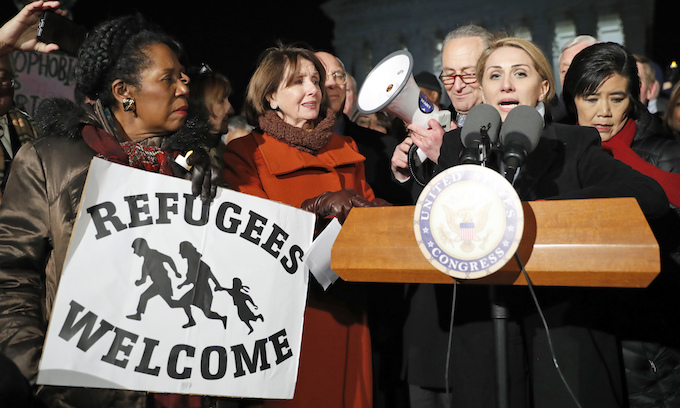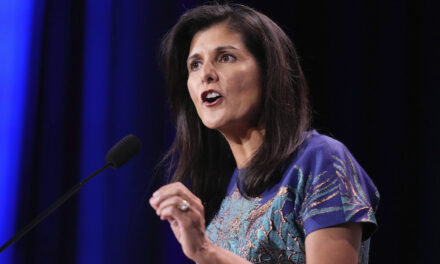America’s governors have overwhelmingly refused President Trump’s offer to exercise a veto over new refugees being sent to their states, in what activists say is a stunning and heartening affirmation of the Statue of Liberty.
New York and Alaska added their names to the list late last week, activist groups said, making at least 41 governors who have now said they will continue to accept refugees. The chief holdouts are a pocket of conservative states ranging from Texas to Florida.
The striking groundswell of support is a rebuff of sorts for Mr. Trump, who has put a chokehold on the country’s refugee program as part of an overall tightening of immigration policy.
“It shows that Lady Liberty still lifts her lamp beside the golden door, despite illegal efforts to extinguish that flame of compassion for those who need it most,” said Krish O’Mara Vignarajah, president of the Lutheran Immigration and Refugee Service.
The local veto was a new innovation Mr. Trump added last year, as he announced another tightening in the total number of refugees the U.S. will accept in 2020. The president issued an executive order saying the State Department could only approve refugees to resettle in jurisdictions where both the state and local governments consented.
The department gave state and local officials until Jan. 21 to make their intentions known.
Governors from both GOP and Democratic states rushed to make clear they want in.
“We are willing to accept refugees who the federal government has determined are properly and legally seeking refugee status and have been adequately vetted,” Maryland Gov. Larry Hogan, a Republican, wrote last week — though he also thanked Mr. Trump for offering states the chance to say “No.”
Activist groups are less enthused about the veto offer.
LIRS, Church World Service and HIAS, formerly known as the Hebrew Immigrant Aid Society, have all sued over the executive order, saying Mr. Trump doesn’t have the authority to offer states and locals a veto.
That case is due for oral argument in a federal court in Maryland on Wednesday.
A ruling against the executive order would make the current consent process moot.
But for now, the State Department is still accepting letter of intent, and refugee advocates are rallying the remaining holdout governors. They’re also working on local officials, who must give consent.
Matthew J. O’brien, research director at the Federation for American Immigration Reform, said local officials have different pressures, and he expects them to be more resistant, erecting barriers that governors wouldn’t.
“The dual consent requirement enables Republican governors in Red States like Tennessee, South Dakota, Oklahoma and Nebraska to avoid Democrat accusations that they are being ‘racist’ — by professing to welcome refugees in their states — while simultaneously relying on municipal officials to actually keep refugees out,” he said.
But Jen Smyers, policy director at CWS, said she’s even more confident in the locals than she was in governors, saying the mayors, councils and boards of supervisors have been on the front lines of refugee resettlement for years.
Already dozens of governments, from Fairfax County on the East Coast to Seattle out west, have signaled they’ll take all comers.
“What this shows is you can’t just turn a light switch off on what has taken decades to build,” Ms. Smyers said.
The biggest holdout at the state level right now is Texas, which is also the biggest player in the refugee resettlement picture. During the Trump administration it has accepted more than 6,300 refugees, or significantly more than any other state.
The Houston Chronicle reported last week that Gov. Greg Abbott has been silent on his thinking about exercising the refugee veto Mr. Trump offered.
California is second with about 5,700. Gov. Gavin Newsome, a fierce Trump opponent, has signaled his state will accept refugees.
Until now, resettlement decisions have been made by the federal government and a group of nine nonprofit resettlement agencies, including LIRS and CWS. They meet regularly to match incoming refugees with communities.
Mr. O’Brien said there have been some bungles, and he wishes those involved in the decisions would do more to match the newcomers with the economic realities of the regions they’re being sent to.
“Placing large numbers of Somali and Sudanese refugees with limited English skills in Lewiston, Maine, which was already struggling economically, doesn’t seem to have been in the best interests of either the refugees or the local residents, all of whom must now compete with each other for scarce entry-level and low-skill jobs,” he said.
But Ms. Vignarajah, the president at LIRS and a refugee herself, said localities that have accepted refugees have found they enhance economies and “make cities and counties safer.”
“While it is concerning that some states have not yet consented, we trust that they will come to the same conclusion so many others have: welcoming refugees isn’t just smart policy — it’s as American as baseball and apple pie,” she said.
The local veto is just part of the Trump administration’s clamp down on refugees. This year’s cap is set at 18,000, down from 30,000 in 2019 and much lower than the more than 105,000 cap President Obama set as he left office in late 2016.
The administration says the country has been overwhelmed by asylum-seekers at the border, and the White House has shifted resources to deal with that, meaning fewer adjudicators are available to vet refugees. Asylum is the designation for those who apply for protection after reaching the U.S., while refugees are those who apply from overseas.
Yet Ms. Smyers said the explanation of tension between refugee and asylum work rings hollow.
She said in 1980, the start of the current refugee system, the U.S welcomed more than 200,000 refugee and asylees. By contrast in 2018 the U.S. granted fewer than 37,000 refugee resettlements and asylum petitions.
© Copyright (c) 2020 News World Communications, Inc.
—-
This content is published through a licensing agreement with Acquire Media using its NewsEdge technology.



















Recent Comments